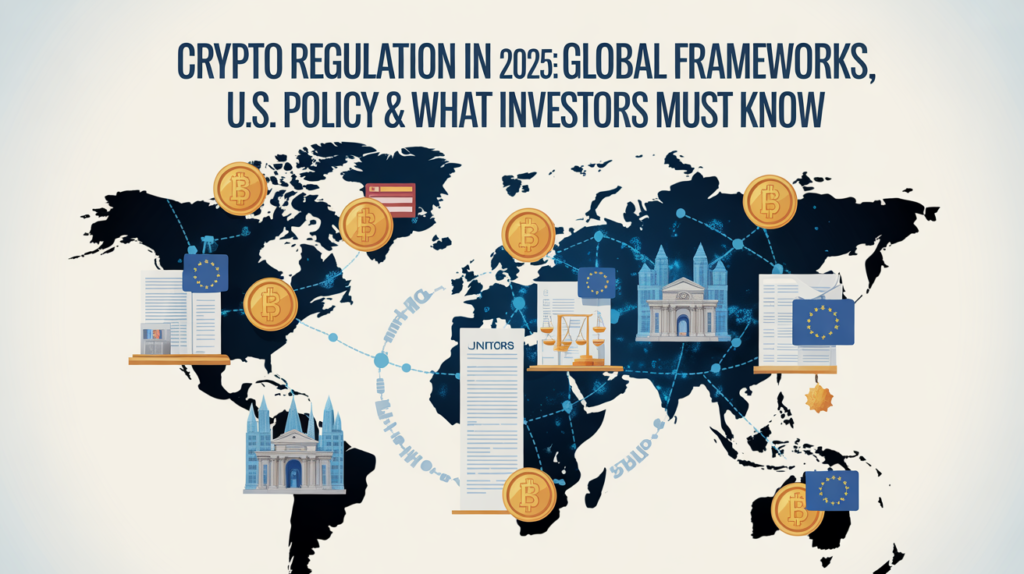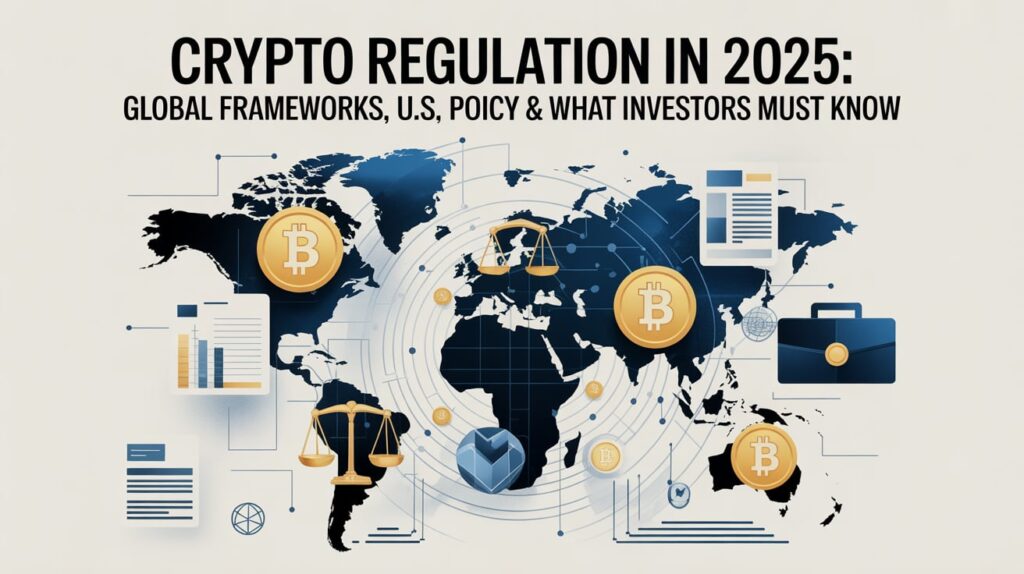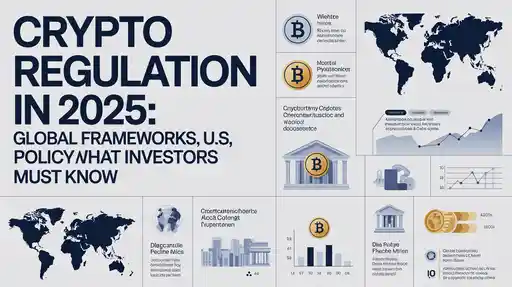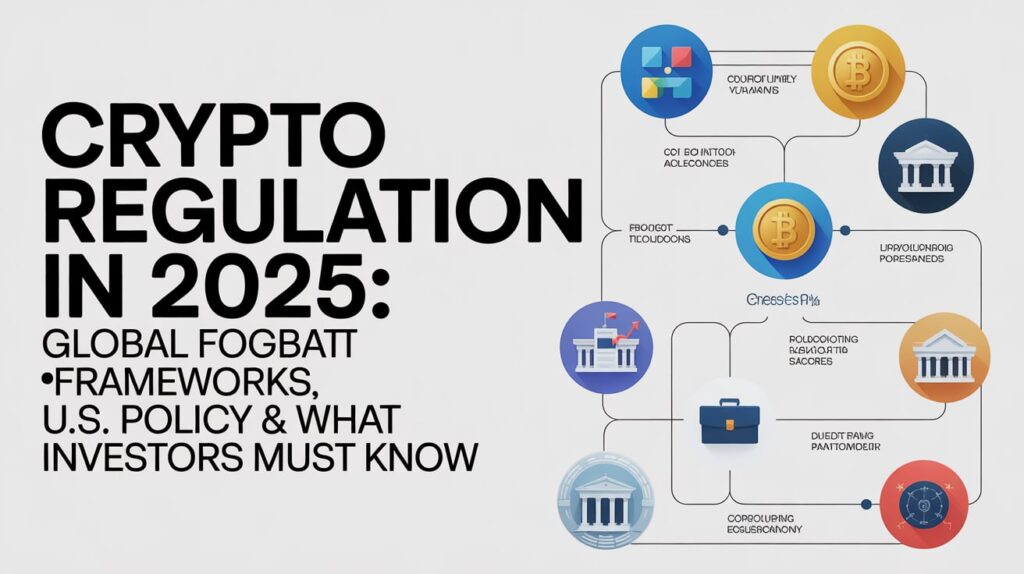Crypto Regulation in 2025: Global Frameworks, U.S. Policy & What Investors Must Know

U.S. federal and state developments, how these affect investors and companies, and practical guidance on navigating compliance and opportunities ahead.
1. Why Crypto Regulation Matters in 2025
1.1 From Wild-West to Mainstream Finance
Cryptocurrencies were once considered fringe, with minimal regulation and high risk. But as institutional interest, DeFi (decentralized finance) growth, stablecoins, tokenization, and cross-border flows all accelerate, the need for clear regulation has become unavoidable.
Regulation matters because it:
-
Reduces uncertainty for investors and businesses
-
Protects consumers and markets from fraud, wash trading and manipulation
-
Aligns digital-asset markets with existing financial infrastructure
-
Enables new financial products (ETFs, tokenized securities, stablecoins) to launch with trust
In short, 2025 is the year crypto regulation moves from catch-up to structure.
1.2 Innovation vs Risk Trade-Off
Regulators are under pressure to both foster innovation and mitigate risk. Too heavy-handed regulation could stifle blockchain and crypto growth; too light leaves markets exposed. In 2025, many jurisdictions are aiming for “innovation-friendly but safe” frameworks. For example, the U.S. Executive Order on digital assets sets innovation as a policy goal. State Street+1
2. Major Global Regulatory Developments
2.1 United States Federal Initiatives
In the U.S., two key developments stand out:
-
The signing of the GENIUS Act on July 18, 2025, which creates the first comprehensive federal law for payment stablecoins. whitehouse.gov
-
The collaboration between the SEC and Commodity Futures Trading Commission (CFTC) clarifying regulatory jurisdiction for spot-crypto-asset trading. InsightPlus
Additionally, U.S. states have ramped up legislation (as documented by the National Conference of State Legislatures) on virtual currencies, money-transmitter laws, digital-asset reserves, and mining. NCSL
2.2 Europe and Other Regions
While the U.S. spearheads many moves, other jurisdictions are advancing too. For example:
-
The EU’s Markets in Crypto‑Assets Regulation (MiCAR) framework (though fully applicable earlier) sets the tone for Europe.
-
Several Asian and Middle-East countries are adopting sandbox regimes for digital assets.
That means global firms must navigate varying regimes, rather than a single “crypto law”.
2.3 State-Level U.S. Landscape
Across U.S. states in 2025:
-
At least 40 states introduced legislation regarding digital assets. NCSL
-
Examples: Arizona requiring kiosk operators to use blockchain analytics; Montana prohibiting state use of a CBDC pilot; Utah investing public funds in certain digital assets.
This fragmentation means companies must consider both federal and state law when operating in the U.S.
3. Key Regulatory Themes in 2025

3.1 Stablecoins & Payment Systems
One of the most discussed themes is stablecoins—tokens pegged to fiat currencies or other assets. Under the GENIUS Act, issuers must maintain backing, audits, and disclosures. Wikipedia+1 Because stablecoins serve as the “on-ramp” to crypto ecosystems, regulation here underpins broader trust.
3.2 Securities vs Commodities Debate
One of the oldest regulatory questions: Are crypto-tokens securities (regulated by the SEC) or commodities (regulated by the CFTC)? In 2025, clearer guidance emerged: for example, joint statements by SEC & CFTC indicate exchanges may list certain spot crypto assets under clearer rules. InsightPlus
3.3 Tokenization and Real-World Assets (RWAs)
Regulation around tokenizing real-world assets (real estate, bonds, art) on blockchain remains nascent but accelerating. Jurisdictions are creating legal recognition for on-chain asset ownership, custody, and transfer.
3.4 Consumer Protection & Anti-Money Laundering (AML)
Regulators are increasingly focusing on issues like money-laundering risk, custody of crypto assets, fraud prevention, disclosure requirements, and investor protection. Kiosk operators, wallets, exchanges must meet AML/KYC standards.
3.5 Interoperability, Consistency & Innovation
Creating flexible frameworks that allow innovation (DeFi, NFTs) yet integrate with existing financial law is a key theme. The U.S. Executive Order of January 2025 signals this shift. State Street+1
4. U.S. Federal Regulatory Highlights
4.1 Executive Order & Working Group
In March 2025, the U.S. administration issued an Executive Order titled “Strengthening American Leadership in Digital Financial Technology”, which among other things established a Presidential Working Group on digital assets. State Street This underscores the federal intent to treat crypto policy as strategic.
4.2 Passage of the GENIUS Act
The Act was passed to address stablecoin regulation federally—backing, audits, disclosures, speakers say. whitehouse.gov+1 This is one of the first major digital-asset laws in U.S. history.
4.3 SEC-CFTC Joint Statements
In September 2025, the SEC and CFTC issued a statement clarifying that registered exchanges may list certain spot crypto asset products—an indication of regulatory clarity. InsightPlus
4.4 Tax, Custody & Accounting Treatment
Regulatory guidance in 2025 is clarifying how crypto custodians treat digital assets on their balance sheets (e.g., rescinding SAB 121 in early 2025). State Street
5. State-by-State U.S. Regulation
5.1 Variation & Fragmentation
While federal law advances, states differ widely. Some are pro-crypto, others cautious or restrictive. For example:
-
Arizona enacted laws requiring disclosure for crypto kiosk operators. NCSL
-
Montana banned state agencies from using public funds for CBDC testing. NCSL
-
Utah authorised investments by the state treasurer in digital assets. NCSL
5.2 Implications for Businesses
Businesses operating across multiple states must navigate various licensing, money-transmitter laws, tax regimes, and consumer-protection rules. Compliance becomes multi-layered.
6. Global Comparative Regulation

6.1 Europe: MiCAR & Beyond
The EU’s MiCAR has already set rules for crypto-asset service providers (CASPs), stablecoins, institutional investor protections. U.S. regulation in 2025 appears to draw inspiration from or aligns with international trends.
6.2 Asia & Middle East
Countries such as Singapore, UAE and Hong Kong are launching digital-asset regulatory regimes, sandboxes, and tokenisation frameworks. Global firms must monitor cross-border regulation and jurisdictional arbitrage.
6.3 Global Coordination
Because digital assets are inherently cross-border, international cooperation (via the Financial Action Task Force (FATF), OECD, BIS) is increasing. Regulation isn’t just domestic anymore—global norms matter.
7. What It Means for Investors & Crypto Companies
7.1 Investors
Regulatory clarity improves confidence—but also imposes more requirements. Investors should:
-
Check whether platforms are licensed/regulatory-compliant
-
Understand how tokens are classified (security vs commodity)
-
Be aware of tax implications and custody risk
-
Consider that regulation may shift costs, fees, or access
7.2 Crypto Start-ups & Projects
Projects seeking to launch tokens, custody solutions, exchanges or DeFi applications must:
-
Design governance and tokenomics with compliance in mind
-
Consider U.S. federal + state licensing
-
Build compliance frameworks (AML/KYC, auditability, disclosure)
-
Work with legal counsel to classify tokens and structure products
7.3 Traditional Financial Institutions
Banks, asset managers and fintechs entering crypto should:
-
Monitor regulatory updates (GENIUS Act implementation, SEC/CFTC guidance)
-
Build infrastructure for custody, compliance, reporting
-
Explore tokenised assets in a regulated environment
8. Challenges & Unresolved Issues
8.1 Classification Ambiguity
Despite progress, many tokens remain in grey zones—are they securities, commodities, or neither? Projects must still navigate uncertain classification.
8.2 Regulatory Lag vs Innovation Pace
Regulation often lags behind innovation. DeFi, NFTs, token-games, layer-2 networks are evolving rapidly while legal frameworks catch up.
8.3 Global Level Playing Field
Different jurisdictions are moving at different speeds. Cross-border regulation, enforcement harmonisation and jurisdictional competition create uncertainty for global firms.
8.4 Cost of Compliance
Smaller projects may face high costs in licensing, auditing, token classification and legal structuring.
8.5 Privacy, Decentralisation, Freedom
Some in the crypto community worry that regulation could undermine core decentralised principles or push innovation offshore.
9. Practical Steps for Navigating Crypto Regulation in 2025

9.1 Monitor Key Regulatory Deadlines
For example: Public comment periods under the GENIUS Act implementation by the U.S. Treasury. Latham & Watkins
9.2 Maintain Good Governance & Documentation
Projects: formal white-papers, audited contracts, clear tokenomics, legal opinions.
9.3 Choose Jurisdiction Carefully
Consider where you are incorporated, licensed, and access customers.
9.4 Use Reputable Platforms
Investors should use exchanges or platforms with known regulatory status, transparent audits, and good track-records.
9.5 Engage Legal & Compliance Advisors
Crypto policy is evolving—professional counsel helps avoid costly mis-steps.
9.6 Educate Stakeholders
From your team to your users, ensure awareness of what regulation means for your product, tokens or investment.
10. Future Outlook: Regulation & Market Structure Post-2025
The regulation of digital assets in 2025 is just the beginning. By 2030, we may expect:
-
Widespread tokenised securities on-chain, regulated like stocks/funds
-
Global interoperability of digital-asset regulation and custody
-
More robust frameworks for DeFi, tokenised real-world assets, and cross-chain regulation
-
Banks, fintechs and crypto firms operating under blended legacy and blockchain-native regulatory regimes
-
Increased clarity on innovation-friendly regulation that balances decentralisation and consumer protection
Conclusion
Crypto regulation in 2025 marks a turning point. The trend is clear: from regulatory ambiguity to structured frameworks, from reactive enforcement to proactive policy. For investors, companies and innovators, understanding this shift is critical. Whether you are building the next token, entering a crypto-native venture, or simply investing—you must factor in regulation not as an afterthought but as a core strategic variable.
In short: 2025 isn’t just another year in crypto—it’s the year regulation caught up and set the stage for the next decade of growth.